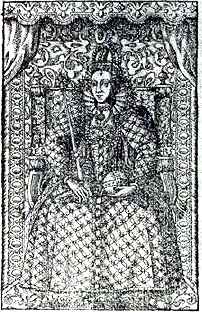Elizabethan fashions
Elizabethan dress was gorgeous and elaborate, mirroring the prosperity and energy of the age.
Queen Elizabeth herself provided an extravagant fashion model--an inventory of her clothing in 1600 included almost 300 gowns and several hundred other costumes, in addition to state apparel. Towards the end of her reign, English dress became increasingly exaggerated, following the eccentric tastes of the aging queen.
The sense of order which governed Elizabethan society also governed the type of dress one could wear. "Sumptuary" laws* outlined the degree of luxury allowed each social class*, although a 1580 statute modified the law to allow some luxury to those who could afford it.
This page provides information on the Tudor Sumptuary Laws.
Footnotes
-
Ecclesiastical support
The Church of England supported the restrictions on clothing. In 1563 a sermon "Against Excess of Apparel" was included in the Second Tome of Homilies and was preached throughout the reigns of Elizabeth and James I.
Philip Stubbes, a puritan, wrote in The Anatomy of Abuses (1583):
Everyone almost, though otherwise very poor, having scarce forty shillings of wages by the year, will be sure to have two or three pair of these silk netherstocks, or else of the finest yarn that may be got, though the price of them be a royal [approximately ten shillings] or twenty shillings, or more.
There was a practical purpose in the regulation of dress; silks had to be imported and therefore often resulted in a trade imbalance.
A stubborn puritan
Born a decade before Shakespeare (c. 1555), Stubbes attended both Oxford and Cambridge. He wrote a number of pamphlets in addition to his Anatomy of Abuses.
-
Classy clothes
A person below the rank of a knight's eldest son, for example, was not allowed to wear satin, damask or taffeta.
